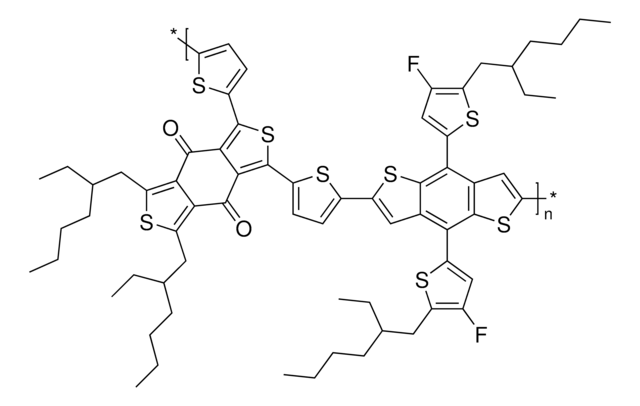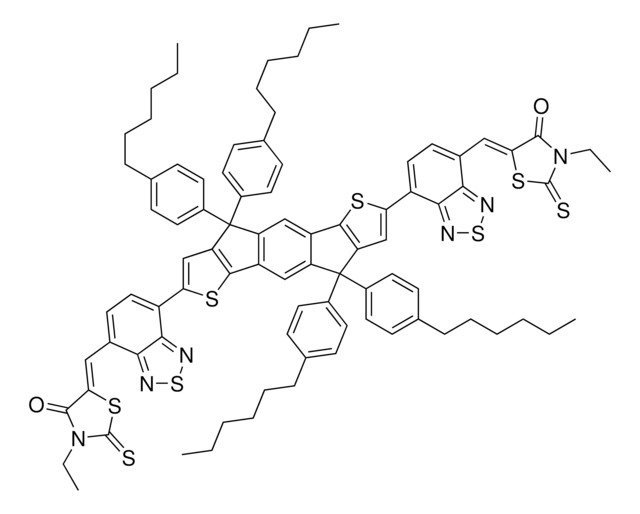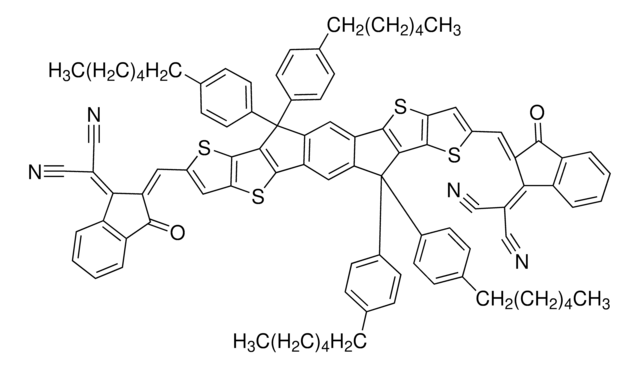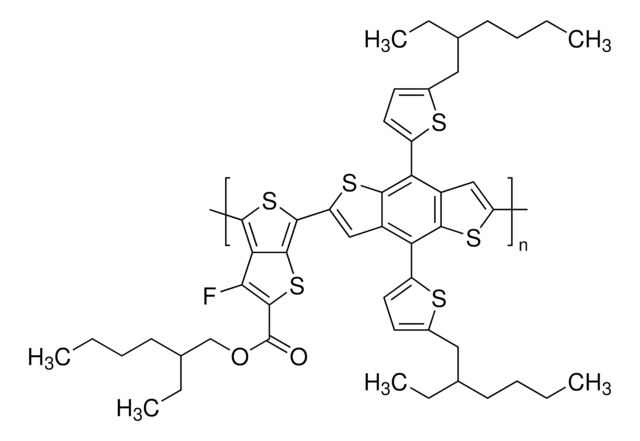913251
Y7
≥99%
Sinónimos:
BTP-4Cl
Iniciar sesiónpara Ver la Fijación de precios por contrato y de la organización
About This Item
Fórmula empírica (notación de Hill):
C82H86Cl4N8O2S5
Peso molecular:
1517.75
UNSPSC Code:
12352101
NACRES:
NA.23
Productos recomendados
General description
Synonym: 2,2′-((2Z,2′Z)-((12,13-bis(2-ethylhexyl)-3,9-diundecyl-12,13-dihydro-[1,2,5]thiadiazolo[3,4-e]thieno[2",3":4′,5′]-thieno[2′,3′:4,5]pyrrolo[3,2-g]thieno[2′,3′:4,5]thieno[3,2-b]indole-2,10-diyl)bis(methanylylidene))bis(5,6-dichloro-3-oxo-2,3-dihydro-1H-indene-2,1-diylidene))dimalononitrile
Application
BTP-4Cl is a high performance, low bandgap, non-fullerene accpetor (NFA). It is the chlorinated derivative of the fused benzothiadiazole-based NFA, Y6. It offer high power conversion efficiency (PCE) when pairing with p-type polymer PM6. A 9 mm2 single junction device of this blend provided a PCE of 16.5% at thickness of ~ 100nm, and provided a PCE of >13% at a thickness of ~300 nm (for the active layer). An impressive PCE of >15% was reached for this blend with a 1 cm2 active layer. In general, Y7 showed improved performances over Y6, mainly due to its highest photoluminescence, lower non-radiative energy loss, and a higher Voc of 0.867 V vs 0.834 V for Y6.
Y7 is a highly conjugated organic semiconductor, electron deficient due to its structure and hence suitable for use as a n-type non-fullerene electron acceptor(NFA) in OPV devices. It has an absorption range that extends to the near infrared (NIR) and has demonstrated a power conversion efficiency (PCE) up to15.7% with PBDB-T-2F (PM6) as the polymer donor.
Storage Class
11 - Combustible Solids
wgk_germany
WGK 3
flash_point_f
Not applicable
flash_point_c
Not applicable
Elija entre una de las versiones más recientes:
Certificados de análisis (COA)
Lot/Batch Number
¿No ve la versión correcta?
Si necesita una versión concreta, puede buscar un certificado específico por el número de lote.
¿Ya tiene este producto?
Encuentre la documentación para los productos que ha comprado recientemente en la Biblioteca de documentos.
Yong Cui et al.
Nature communications, 10(1), 2515-2515 (2019-06-09)
Broadening the optical absorption of organic photovoltaic (OPV) materials by enhancing the intramolecular push-pull effect is a general and effective method to improve the power conversion efficiencies of OPV cells. However, in terms of the electron acceptors, the most common
Contenido relacionado
Organic electronics utilizes organic conductors and semiconductors for applications in organic photovoltaics, organic light-emitting diodes, and organic field-effect transistors.
Nuestro equipo de científicos tiene experiencia en todas las áreas de investigación: Ciencias de la vida, Ciencia de los materiales, Síntesis química, Cromatografía, Analítica y muchas otras.
Póngase en contacto con el Servicio técnico






![[6,6]-Phenyl C71 butyric acid methyl ester 99%](/deepweb/assets/sigmaaldrich/product/structures/716/624/9fb9f2f0-ae99-429f-8d3a-b12267976a4d/640/9fb9f2f0-ae99-429f-8d3a-b12267976a4d.png)
